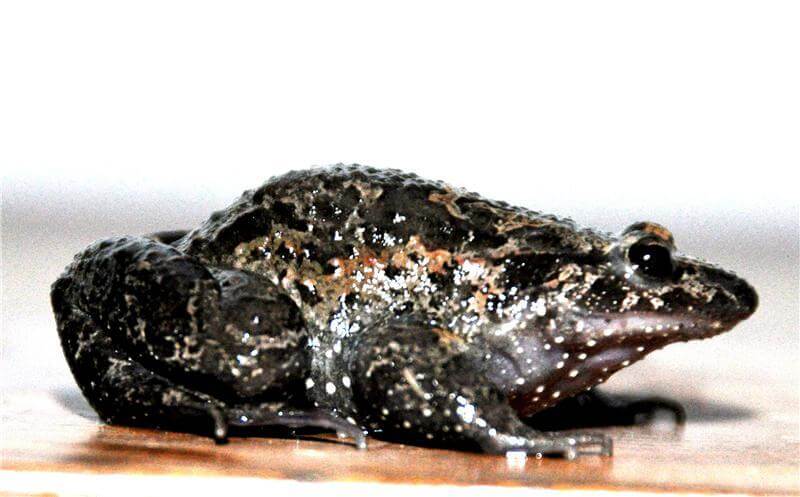A study published in the journal Nature by German and French Israeli researchers indicates that the relative of the Israeli frog has been considered extinct for 15 thousand years

The black-tongued round-tongue, the first amphibian that was officially declared extinct after not being seen for about 60 years by the International Union for Conservation of Nature (IUCN) and rediscovered in the north of Israel about two years ago, was declared a unique "living fossil" that has no direct relatives among creatures life today
As I recall, the round tongue was rediscovered in November 2011 by Yoram Malka, an inspector of the Hula reserve, during a routine patrol. The black-bellied round-tongue was initially cataloged in the genus Discoglossus when it was discovered in the Hula Valley in the 20s. The frog was declared an extinct species with the drying up of the Hula reserve in the late fifties and in 1996 it was officially declared extinct by the IUCN. As a result, the chances of finding out more about the history, biology and ecology of the species were considered low.
However, researchers from Israel, Germany and France report in the journal Nature about an in-depth scientific analysis of this enigmatic amphibian species. The research was led by Professor Sharig Gafni from the Rupin Academic Center and Professor Eli Gafni from Tel Aviv University. The two were assisted by researchers from Germany and the Weizmann Institute, as well as Rebecca Beaton and Dr. Rebecca Rabinovitz from the Hebrew University and people from the Nature and Parks Authority.
Based on a genetic analysis of individuals that were rediscovered as mentioned above and a morphological analysis of fossilized frog bones, the conclusion was that the round-tongue is distinctly different from living species close to it - the painted frogs from North and West Africa. Instead, the round-tongue is closer to a type of fossilized frog - Latonia, whose fossils have been discovered all over Europe, and they date back to the prehistoric period and were thought to have been extinct for a million years.
The results of the study show that the frog drawn from the patient is no longer a rare species of frog, but in fact the only representative of an ancient branch of frogs (clade - a group of descendants of a common ancestor).
According to the researchers, the Israeli species of the round-tongued was created 40-50 million years ago, and the European species only 25 million years ago. Latonia was the 'youngest' fossil of the species and it is considered a species that became extinct 15 thousand years ago and it turns out that one branch of it lives to this very day in Lake Hula.
Plans to re-flood part of Hula Lake and restore the marsh environment are underway, and this may expand the size of the round-tongue population and secure its future.

7 תגובות
In the meantime, pending clarification, I added the sentence myself
Absalom, I replied to you by email. I asked the advertisers to add a caption that this is an advertising article.
Completely agree with the commenter!
Father, the possibility that marketing content appears on this website under the guise of a scientific article without being able to distinguish it (and worse than that, the marketing "article" is actually protected from comments!) is shocking and means the destruction of the entire enterprise you have built over many years.
You should come to your senses and clarify the matter to the readers.
There is also room for an apology.
This time I missed. In the next contract I will try to fix this
It really shouldn't be that the excellent website is only free for those who pay entrance fees! It is definitely better to have advertising articles.
But still - it is appropriate to put at least a small hint that this is an advertising article - especially on such a charged topic. After all, there is misleading the public here! Even in "regular" newspapers there is a rule that advertising articles should have a title like: "advertising section". Otherwise, people may realize that the experts of the "Hidan" site have a scientific insight that the genetic medical insurance is really beneficial to the consumer, but it is not really so!
Here, you have commented on one of the other 15,600 articles on the site. The alternative to your claims is that you will have to finance the site's expenses through entrance fees.
Why was the possibility to respond to the article "The heart follows genetics" blocked? This is an advertisement disguised as an article, and it would not be appropriate for the "Hidan" website to disguise an advertisement article as if it were scientific information.
The truth is that keeping genetic information in the hands of insurance companies is an ethical problem. The insured people are not clear about the risks of providing such information. For example: 1. Exposing one person's medical information also exposes his relatives. 2. A person submits his DNA for testing and cannot regret it - any future information, which now is not even known to exist - is revealed. 3. The more "suspicious" medical information the insurance company has, the higher the insured's insurance cost will increase. Maybe not today - but in the not too distant future. 4. The insurance company also guarantees confidentiality - it is well known how hacked the databases are.
These are just examples.
It is inappropriate to block such an article from comments!